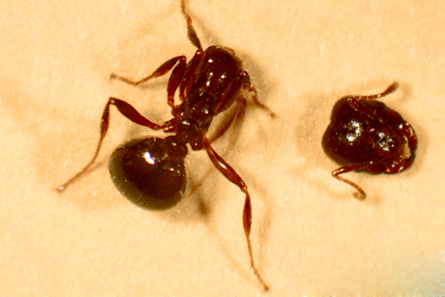Venom attracts decapitating flies
Chemistry may help scientists improve control of invasive fire ants
- More than 2 years ago
A fire ant’s weapon is also its weakness. The insect’s venom attracts parasitic flies, which bring about a slow ant death that ends in decapitation, scientists report in an upcoming Naturwissenschaften.


By identifying venom alkaloids that attract the flies, researchers may be able to better monitor populations of the pests and their enemies and to design improved fire ant control strategies.
Fire ants were imported from South America in the early 20th century and, with little competition and no natural enemies, quickly became a major pest in the southeastern United States. Knowing that phorid flies were ant decapitators, scientists began releasing the flies as a biocontrol agent in the 1990s in the United States. But scientists didn’t know which chemical cues guided flies to their victim ants, and the control efforts, while successful in some areas, have not yet fully quelled the fire ant problem.
Fire ants have more than 10 glands, and which ones held the attractant wasn’t clear, says entomologist Henry Fadamiro of Auburn University in Alabama, who led the new research. Fadamiro and colleagues hooked electrodes up to the antennae of flies to investigate which of several stimuli prompted nerves to fire. By exposing the antennae to extracts from different ant glands and body parts, the researchers determined that juice from the venom glands got antennae buzzing. Fire ant venom is about 90 percent alkaloids, nitrogen-containing compounds that are often toxic. Separating the venom into its chemical components allowed the team to pinpoint specific compounds that the flies favored. Further tests, in which flies chose their favored scent, confirmed the antennae tests.
In South America, fire ant densities are one-tenth to one-fifth what they are in the United States, notes entomologist Sanford Porter, a fire ant specialist with the U.S. Department of Agriculture’s Agricultural Research Service in Gainesville, Fla. South America has phorid flies and other natural fire ant enemies that control the population, he says. “We hope if we get the right combination that these biocontrol methods will begin to really make a difference.”
Designing baits with attractive alkaloids may help researchers monitor fly populations and understand where flies thrive. This in turn could reveal where the flies will be most successful in suppressing ant populations.
Fire ants are typically not afraid of anything — they do as they please, Fadamiro notes. But when phorid flies, half the size of a grain of rice, begin to hover nearby, the ants “start to run helter-skelter,” he says. And with good reason. If an ant doesn’t get a move on, the fly drops down and deposits her egg in the ant’s chest.
For a few days, fly-carrying ants walk around normally. By two weeks later, the ant is in a daze and other ants remove it from the colony. By now the fly has migrated to the ant’s head and is ready to pupate. It begins to secrete enzymes that decapitate the ant.
Scientists aren’t sure why the flies bother to cut off the head. It may serve as an escape pod from residual toxins in the near-empty body.






